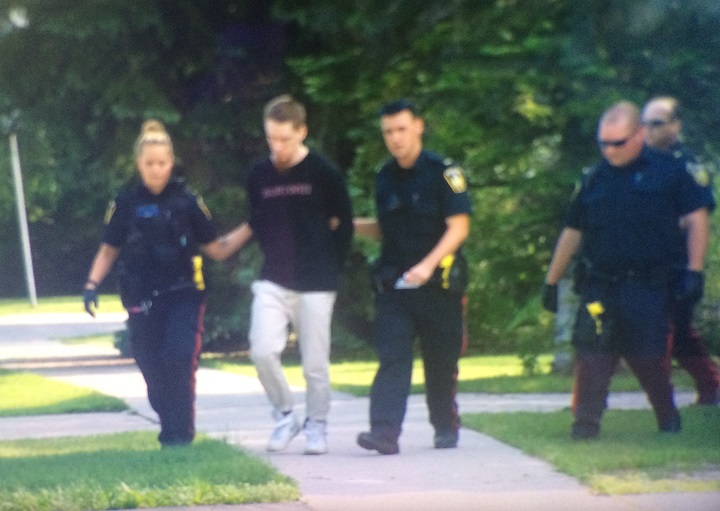On the afternoon of August 10, 2016, police confronted Aaron Driver outside his house in Strathroy, Ont. as he was leaving to carry out a bombing in support of the so-called Islamic State. Cornered, he triggered an explosion and police shot him dead.

Almost a year later, two investigations into the terrorist incident are still underway, Global News has learned. Both the RCMP and the Office of the Chief Coroner for Ontario are continuing to examine aspects of the failed ISIS-inspired bomb plot.
The RCMP said its Integrated Technological Crime Unit was working to reconstruct an “electronic device” that was damaged when Driver, 24, triggered one of his homemade bombs in the back seat of a taxi he had called to take him to a London, Ont. mall.
“We do have some electronic devices that were seized and that we’re trying to reconstruct,” James Malizia, the RCMP Assistant Commissioner for national security criminal investigations, said in an exclusive interview.
The contents of the device remain unknown, the RCMP said. “And so until such time as that work is completed and we get a good opportunity to analyze that information, we’re not in a position to comment on that case,” Malizia said.
The chief coroner’s office said its investigation also remained unfinished. The Inquest Advisory Committee had not yet reviewed the matter “so a decision regarding whether there will be an inquest is pending,” said Julia Noonan-Savage, a strategic advisor to the chief coroner.
A joint investigation by the Ontario Provincial Police and Strathroy-Caradoc Police Service wrapped up last November, concluding the police shooting of Driver was justified. An independent review by the Crown upheld the finding.
A troubled Muslim convert, Driver was arrested in Winnipeg in 2015 after posting pro-ISIS propaganda on social media under the alias Harun and communicating with prominent ISIS figures responsible for trying to incite attacks in Western countries.
Rather than laying terrorism charges against Driver, police instead obtained a peace bond that, among other things, forbid him from using a cell phone, computer, laptop, tablet “or similar electronic device” without RCMP permission. He later moved to his sister’s home in Strathroy.
Police converged outside the house on August 10 after Driver, his face concealed under a balaclava, recorded a video accusing Canadians of being part of a “war on Islam” and promising “spilling of your blood.” When a taxi pulled into his driveway, Driver got in the back and police confronted him.
Driver then set off a small explosion and came out of the cab saying Allahu Akhbar, “God is the greatest,” according to police. Believing he might be trying to trigger a bomb, police shot him dead. ISIS later claimed responsibility, calling Driver a “soldier of the Islamic State.”
Coming after the killings of Canadian Forces members in Saint-Jean-sur-Richelieu, Que. and Ottawa, and a subsequent knife attack in a Toronto military recruiting office, the close call was a reminder of the ongoing threat of terrorism.
It also raised questions about how closely extremists were being monitored, given that Driver was known to police as an ISIS supporter and was the subject of a terrorism peace bond at the time he built bombs and packed ball bearings around them to make them deadlier.
WATCH: Daniel Tobok, a digital forensics expert and CEO of Cytelligence Inc., explains what the RCMP is looking for on Aaron Driver’s electronic device and how it could assist their ongoing counter-terrorism investigation.

Police have said little about the investigation since last August, and would not reveal what kind of device they were working on reconstructing, or whether it was used to detonate the explosion, but an expert said even electronics damaged by a bomb could yield crucial evidence.
“It depends on where the hard drive was damaged. You’d be surprised but those storage devices are extremely resilient. So when you look at a phone or an iPad and they get damaged, the device can be crumpled up, it doesn’t matter. Still data can be recovered,” said Daniel Tobok, a digital forensics expert and CEO of Cytelligence Inc.
But he said the work, done by highly specialized members of technical crime units, can take a long time. In one case, it took 18 months to put a device back together following an explosion, he said. “It’s a very tedious process requiring lots of expertise and patience.”
While there’s no guarantee police will succeed in extracting data from a damaged device, he said in a terrorist case they would be hoping to identify plans, associates and financiers.
“It provides an enormous amount of intelligence when devices are seized of a suspect, especially in a terrorism situation. It can tell a really big story.”
Driver’s father Wayne told Global News he had not been officially informed of the progress of the investigations. He said all he knew was what he was told a year ago: that his son had set off an explosive device and was shot while trying to detonate another.
The attempted terrorist attack came as a shock to Strathroy, a town of 20,000 about 40 kilometres west of London. Residents wondered why they had never been told a known ISIS supporter was living among them. But the mayor said the community had now moved on.
“I don’t hear anything on the street,” Joanne Vanderheyden said in an interview. She said Strathroy was safe and noted the magazine Money Sense had recently rated it the 37th best place to live in Canada.
“We want to look forward. We don’t look back,” she said. “That was an incident that we’re not going to dwell on.”










Comments